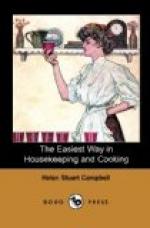In using wood, the same principles apply; but of course the fire must be fed much oftener. Grate-fires, as well as those in the ordinary stove, are to be made in much the same way. In a grate, a blower is fastened on until the coal is burning well; but, if the fire is undisturbed after its renewal, it should burn from six to eight hours without further attention. Then rake out the ashes, add coal, put on the blower a few minutes, and then proceed as before. If an exceedingly slow fire is desired, cover the top with cinders, or with ashes moistened with water. In making a grate or stove fire, keep a coarse cloth to lay before it, that ashes may not spoil the carpet; and wipe about the fire-place with a damp, coarse cloth. In putting on coal in a sick-room, where noise would disturb the patient, it is a good plan to put it in small paper bags or in pieces of newspaper, in which it can be laid on silently. A short table of degrees of heat in various forms of fuel is given below; the degree required for baking, &c, finding place when we come to general operations in cooking.
DEGREES OF HEAT FROM FUEL.
Willow charcoal 600 deg. Fah.
Ordinary charcoal 700 deg. Fah.
Hard wood 800 deg. to 900 deg. Fah.
Coal 1000 deg. Fah.
Lights are next in order. Gas hardly requires mention, as the care of it is limited to seeing that it is not turned too high, the flame in such case not only vitiating the air of the room with double speed, but leaving a film of smoke upon every thing in it. Kerosene is the oil most largely used for lamps; and the light from either a student-lamp, or the lamp to which a “student-burner” has been applied, is the purest and steadiest now in use. A few simple rules for the care of lamps will prevent, not only danger of explosion, but much breakage of chimneys, smoking, &c.
1. Let the wick always touch the bottom of the lamp, and see that the top is trimmed square and even across, with a pair of scissors kept for the purpose.
2. Remember that a lamp, if burned with only a little oil in it, generates a gas which is liable at any moment to explode. Fill lamps to within half an inch of the top. If filled brimming full, the outside of the lamp will be constantly covered with the oil, even when unlighted; while as soon as lighted, heat expanding it, it will run over, and grease every thing near it.
3. In lighting a lamp, turn the wick up gradually, that the chimney may heat slowly: otherwise the glass expands too rapidly, and will crack.
4. Keep the wick turned high enough to burn freely. Many persons turn down the wick to save oil, but the room is quickly poisoned by the evil smell from the gas thus formed. If necessary, as in a sick-room, to have little light, put the lamp in the hall or another room, rather than to turn it down.




